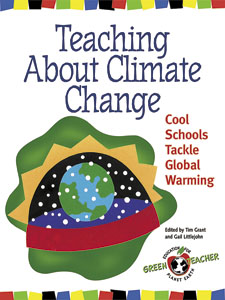Teaching About Climate Change
*Sold Out*
Helping teachers and students to tackle the challenging topic of climate change, this anthology from Green Teacher offers a framework for teaching fundamental concepts and a variety of activities that can be undertaken in school, at home or in the community. Teachers will find practical ideas for making the intangibles of climate change more concrete to students, including experiments that demonstrate the greenhouse effect, school energy and waste audits, and hands-on explorations of energy and transportation alternatives from solar cookers to bike-a-thons. Up-to-date lists of learning resources and related organizations round out the collection of the best of Green Teacher on the topic of climate change.
Introduction
By Tim Grant and Gail Littlejohn
There can be little doubt that climate change will be a significant issue, and possibly the central challenge to humankind, during the lifetime of today’s students. In the past few decades, human activities have raised atmospheric concentrations of greenhouse gases to their highest level in 420,000 years, and a growing body of scientific research predicts rising temperatures and large scale alterations in weather patterns that will continue through the 21st century, even if we manage to curtail greenhouse gas emissions. Yet climate change is a phenomenon with which we humans have little experience, at least in historic times, and teaching about it presents special challenges to educators. The topic is complex because the Earth’s systems are complex, and scientists themselves are not at all certain of the potential ramifications of our interference with these systems. Equally formidable from an educator’s point of view is the intangibility of climate change: its global scale and seemingly slow progression make it a phenomenon that does not easily lend itself to classroom demonstration. And teachers and students who wish to take action on climate change find themselves up against the ingrained habits and attitudes of an industrial society created and powered by fossil fuels and supported by political inertia in establishing regulatory policies to curb greenhouse gas emissions.
Despite these obstacles, teaching about and taking action on climate change may not be as difficult as it seems. All it takes is a starting point. Accordingly, this book is intended as a primer to help teachers and students begin to explore some of the key questions related to climate change: What are its causes? What might we expect? What are governments doing about it? And, most important, what can schools and students do about it? In working with young people, teachers have a great many opportunities to address these vitally important questions. Many topics that would be part of a study of climate change are already part of most curricula: these include, for example, technology topics such as energy systems; social studies topics such as political decision-making; or geography and science topics such as weather systems, photosynthesis and decomposition, and adaptations of plants and animals to specific habitats and climatic conditions. Moreover, many teachers and students are already engaged in activities that are helping to reduce their own and their schools’ greenhouse gas emissions: planting trees near the school building, replacing asphalt surfaces with native plant gardens, conserving energy and water, reducing waste, walking or cycling to school instead of driving. It is only a small step to incorporate discussion of climate change into these curricular areas and activities.
To help teachers find their own best starting point, the contributors to this book — all educators themselves — present a diverse array of learning activities for all age levels. Readers will find basic background information on the greenhouse effect and climate, accompanied by simple experiments that help students understand key concepts. As an aid in planning a unit or course of study, Milton McClaren and William Hammond outline a broad and balanced conceptual framework for climate change education which can be adapted for various grade levels. The core of the book, however, is activities that can be undertaken at school, at home and in the community to raise awareness and take action on reducing greenhouse gas emissions. Since transportation accounts for the largest portion of individual emissions, explorations of transportation alternatives figure prominently, but there are also ideas for investigating energy options and sustainable practices that would lessen our dependence on fossil fuels. Our aim throughout has been to suggest practical pathways into the topic of climate change, to invite teachers and students to examine the choices that lie ahead for us as a society, and to take action now in the belief that we cannot afford to wait until our politicians agree that it is time to do so.
Leave a Reply
You must be logged in to post a comment.







Will “Teaching About Climate Change” become available again soon?
Hi Jennifer,
We will soon publish a new ebook called ‘Teaching Teens about Climate Change’.
If you are interested, please send us an email at info[at]greenteacher[dot]com.
Thank you!